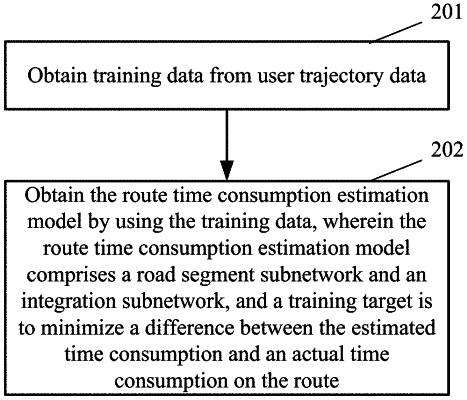| CPC G01C 21/3492 (2013.01) [G01C 21/3626 (2013.01); G06F 18/214 (2023.01); G06N 3/08 (2013.01)] | 16 Claims |

|
1. A method for building a route time consumption estimation model, wherein the method comprises:
obtaining training data from user trajectory data, the training data comprising: a route through which a user passes, time information when the user passes through the route, and actual time consumption information for the user to pass through the route;
obtaining the route time consumption estimation model by using the training data, wherein the route time consumption estimation model comprises: a road condition subnetwork and an integration subnetwork;
the road condition subnetwork estimating road condition feature representations of road segments included by the route by using the time information and road network feature representations of road segments included by the route;
the integration subnetwork determining an estimated time consumption on the route according to a feature representation of the time information, vector representations of the road segments included by the route and road condition feature representations of the road segments included by the route;
a training target of the route time consumption estimation model being to minimize a difference between the estimated time consumption and an actual time consumption on the route,
wherein a feed-forward is performed during the training according to a loss function corresponding to the training target to update parameters of the route time consumption estimation model, and the parameters of the route time consumption estimation model comprises parameters of the road condition subnetwork and the integration subnetwork,
wherein the estimating the road condition feature representations of the road segments by using the time information comprises:
obtaining road condition features of the road segment at time points in a preset historical time length before the time information;
concatenating road network features of the road segment, the road condition features at time points in the preset historical time length before the time information and features of the time points in the historical time length, to obtain a spatiotemporal tensor corresponding to the road segment;
mapping the spatiotemporal tensor using an attention mechanism to obtain the road condition feature representation for estimating the road segment,
wherein in the concatenating, performing random masking on partial road condition features at time points in the preset historical time length to cover partial road condition features and replace the covered road condition features with a zero vector.
|